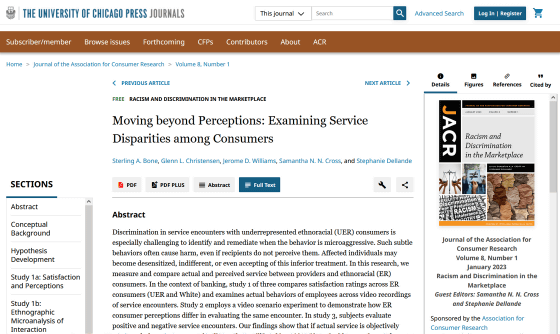Research results show that people of color are so used to discrimination that they are less likely to notice poor service in stores

Racial and ethnic discrimination is deeply rooted in various aspects of daily life, and companies' customer service can change depending on the race of the person they are talking to. In recent years, companies have been trying to eliminate racial discrimination, but a new study that sent 'three undercover investigators of different races' to banks to investigate customer service found that people of color may be less likely to notice poor customer service because they are accustomed to being treated discriminatory on a daily basis.
Moving beyond Perceptions: Examining Service Disparities among Consumers | Journal of the Association for Consumer Research: Vol 8, No 1

People of color get so used to discrimination in stores they don't always notice bad customer service
https://theconversation.com/people-of-color-get-so-used-to-discrimination-in-stores-they-dont-always-notice-bad-customer-service-201766
Many large companies with service sectors, such as banks and airlines, use satisfaction surveys to gather customer feedback and find ways to improve their services. This system is based on the assumption that all customers will perceive poor service as 'bad service' and good service as 'good service.'
So, in order to find out whether customers really perceive the service they receive correctly, a research team led by Sterling Vaughn, a marketing professor at Utah State University in the United States, sent secret investigators into banks to analyze the quality and evaluation of customer service.

For the experiment, the research team recruited nine men living in Los Angeles as researchers. All nine were of similar age, height, build, and education level, but three were white, three were black, and three were Hispanic. The research team then had the nine men wear the same shirt and pants and send them to a total of 69 banks to apply for loans based on the same customer profile.
The nine men all had small cameras embedded in their shirts to secretly record their conversations with bank employees, and they also answered questionnaires to evaluate their satisfaction with each bank. The survey method was approved by the state attorney general's office and was not considered to be legally problematic.
The researchers analyzed satisfaction surveys completed by nine men and found that people of all races were equally satisfied with the way banks treated them, but because past research has shown that black and Hispanic people are objectively treated worse, they decided to dig deeper.
Analysis of the videos filmed by the men revealed that black and Hispanic men faced various forms of subtle discrimination, such as shorter meetings and longer wait times to see bank employees than white men. In other words, even though black and Hispanic men faced objective discrimination, subjective surveys showed that they were no different in satisfaction from white men.

In a follow-up experiment, the team recruited 300 racially diverse participants to watch a video of a meeting between nine men and a bank employee. They then rated the bank employee's response. They found that people of all races rated positive responses as equally satisfying, while blacks and Hispanics rated negative responses as less satisfactory than whites.
'Unfortunately, customers of discriminated ethnic or racial backgrounds may become indifferent or desensitized to and accept repeated discriminatory service over time,' say Vaughn et al. 'In one-to-one interactions, such as at a bank branch, customers may be less likely to notice discriminatory service because they cannot directly compare the service they received with other customers.'
Therefore, even if subtle, inconspicuous
The research team pointed out that discrimination, especially in financial services such as the banks selected for this experiment, could have widespread harms, making it harder for people of color to get loans or save. 'To avoid these problems, managers need to find and improve more objective ways to assess discriminatory treatment of underrepresented customers,' Born and his colleagues said.

Related Posts:
in Science, , Posted by log1h_ik







